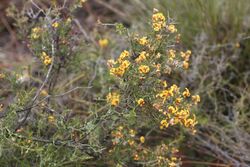Biology:Mirbelia depressa
| Mirbelia depressa | |
|---|---|

| |
| Near Eurardy | |
| Scientific classification | |
| Kingdom: | Plantae |
| Clade: | Tracheophytes |
| Clade: | Angiosperms |
| Clade: | Eudicots |
| Clade: | Rosids |
| Order: | Fabales |
| Family: | Fabaceae |
| Subfamily: | Faboideae |
| Genus: | Mirbelia |
| Species: | M. depressa
|
| Binomial name | |
| Mirbelia depressa E.Pritz.[1]
| |
Mirbelia depressa is a species of flowering plant in the family Fabaceae and is endemic to Western Australia. It is an erect or spreading, prickly shrub that typically grows to a height of 0.15–1 m (5.9 in–3 ft 3.4 in) high and has yellow or orange and reddish-brown flowers from August to October.[2] It was first formally described in 1904 by Ernst Georg Pritzel in the Botanische Jahrbücher für Systematik, Pflanzengeschichte und Pflanzengeographie.[3][4] The specific epithet (depressa) means "pressed down", referring to the low habit of this species.[5] This mirbelia grows on sandplains and is widespread in the Avon Wheatbelt, Coolgardie, Esperance Plains, Geraldton Sandplains, Gibson Desert, Great Victoria Desert, Mallee, Murchison and Yalgoo and bioregions of Western Australia, and is listed as "not threatened" by the Government of Western Australia Department of Biodiversity, Conservation and Attractions.[2]
References
- ↑ "Mirbelia depressa". Australian Plant Census. https://biodiversity.org.au/nsl/services/apc-format/display/96948.
- ↑ 2.0 2.1 "Mirbelia depressa". FloraBase. Western Australian Government Department of Parks and Wildlife. https://florabase.dpaw.wa.gov.au/browse/profile/4089.
- ↑ "Mirbelia depressa". APNI. https://id.biodiversity.org.au/instance/apni/521825.
- ↑ Pritzel, Ernst G.; Engler, Adolf (1904). "Fragmenta Phytographiae Australiae occidentalis. Beitrage zur Kenntnis der Pflanzen Westaustraliens, ihrer Verbreitung und ihrer Lebensverhaltnisse". Botanische Jahrbücher für Systematik, Pflanzengeschichte und Pflanzengeographie 35 (2-3): 230. https://www.biodiversitylibrary.org/item/660#page/259/mode/1up. Retrieved 28 June 2022.
- ↑ Sharr, Francis Aubi; George, Alex (2019). Western Australian Plant Names and Their Meanings (3rd ed.). Kardinya, WA: Four Gables Press. p. 181. ISBN 9780958034180.
Wikidata ☰ Q15534701 entry
 |

